Creative South 2015 Liveblog
Paste’s Sarah Lawrence will be live blogging the event, which kicks off Thursday at 8:00 AM.
Creative South is an annual design conference taking place in Columbus, Georgia—designers from all over the region flock to this small town to hear from the greats, such as Molly Jacques, Sean McCabe, and Aaron Draplin. Check out our preview of this year’s conference here, and follow along as we cover this event live below.
Danielle Evans—Food Typography Workshop
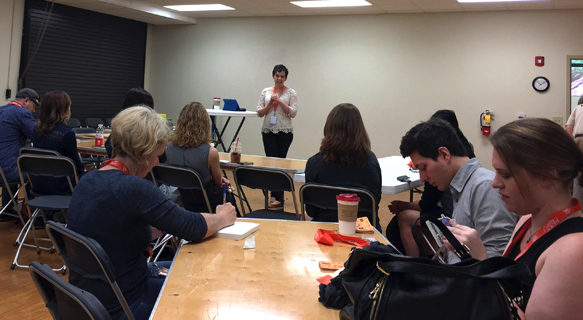
Danielle was working for herself, broke, recovering from some bad gigs. She was afraid to be compared to Jessica Hische and Jon Contino, wasn’t confident as a letterer. “Good design is like a cup of coffee—you’re not just drinking a beverage, you’re having an experience.” A friend suggested she actually make something out of coffee, so she does, and ends up getting a lot of great feedback. Her degree is in illustration, but she was able to use it more effectively this way. “I like to embrace a lack of control,” she says. Sometimes you don’t know how something is going to work or play out, and that’s okay. You have to be willing to adjust.
—By Sarah Lawrence, April 9th at 10:23 AM

Dustin Lee—Passive Income for Designers Workshop
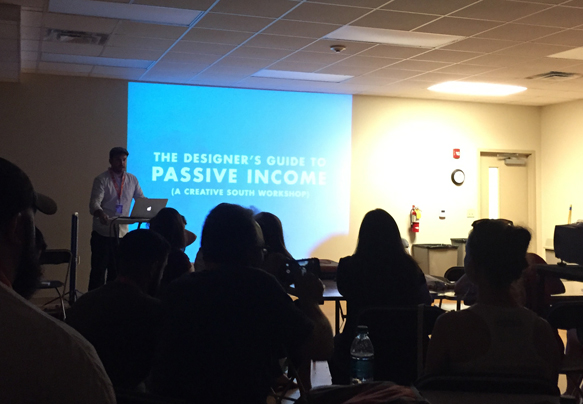
Full house for this workshop! This makes sense, since designers are all about the side hustle and making their work go as far as possible. Dustin started RetroSupply Co on Creative Market about 20 months ago, and has become one of the top few sellers on the platform. A passive income structure, Dustin says, can even out your irregular freelancer income. First, you need to choose your niche, or, figure out what you’re good at. Spend a few hours a week creating digital products you can sell, and with discipline, it can be your side income. Dustin recommends Envato and Creative Market, among others.
—By Sarah Lawrence, April 9th at 1:44PM

Rob Davarnia—Crafting Websites Workshop
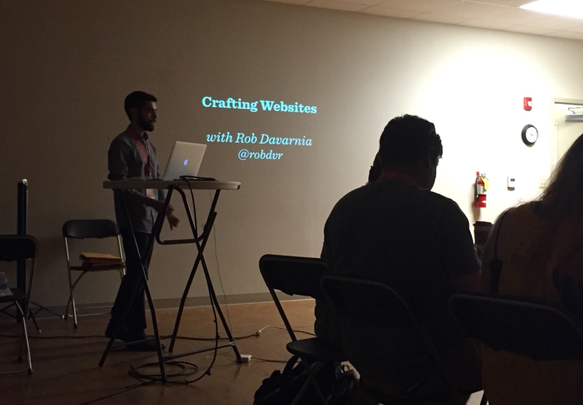
Today in Rob’s workshop we won’t be actively coding, we’re going to be learning the fundamentals behind good web design, from improving code to improving PSDs to make them the best for web viewing. He starts the workshop by explaining terms like “servers,” “domains,” and “domain nameservers.” (We’re guessing you’ve heard of at least the first two.) If you’re on a Google Chrome browser, did you know you can right-click on a webpage and inspect the element to see how it was coded? Seriously cool for a budding web designer.
It’s hard to build an effective website—you need to think like your user. Rob showed us a heat map of a website, showing where a user’s eye lands most often—the reddest area of the map makes an F shape at the top-left of the window. Where is someone looking on your site? What content do they need first? Your website shouldn’t have too many features and overwhelm people. Less is more! Make sure to get feedback on your site. It’s okay to make and fix mistakes.
—By Sarah Lawrence, April 9th at 3:45PM

Bob Ewing & Ian Barnard—Lettering and the Vector Machine Workshop

Some practical (and quick) tips from letterers Bob Ewing & Ian Barnard on lettering in Illustrator:
—Use the Blend tool to produce a drop shadow (CMD+C your original drawing, lock it. Paste in place with CMD+Shift+V, Alt-click and drag away from the shape. Highlight both, use the Blend tool at ~50)
—Round the intersections of letters with the Corner Widget, or the Shape Builder tool
—Handles of Bezier curves should be either perfectly horizontal or perfectly vertical (while you can break this rule sometimes, try to adhere to it).
—By Sarah Lawrence, April 9th at 4:58PM

Von Glitschka—Anatomy of a Logo
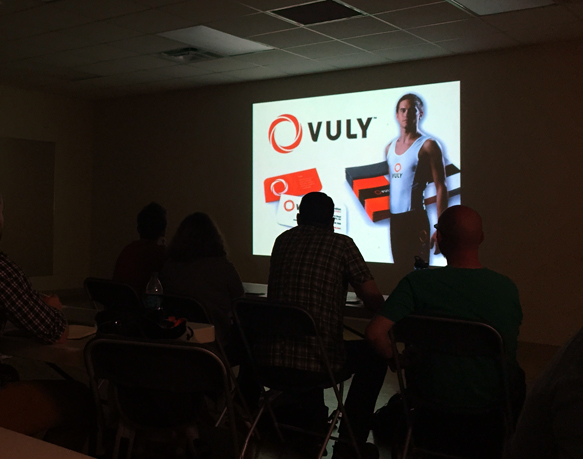
Von Glitschka really lays it down for logo design; moving from the research and exploratory process, to pricing, to finalizing a brand mark. He goes through several case studies from his own studio, explaining various steps of the branding and rebranding process. Discussing legal matters was of special importance to budding designers in the room—remember, remember to always have a contract, or even a written agreement for a project. When embarking on a new project with a client, make sure you ask the right questions up front and figure out what they want. As much as you might be eager for any work, know when a company is full of red flags and when you should walk away.
The workshop went on to feature a challenge from guest “client” Sven (clad in a blonde wig and Scandinavian accent), who tasked the audience with designing a brand for his new cologne company.
—By Sarah Lawrence, April 9th at 5:29PM
We opened the day with a group prayer in the Springer Opera House, led by conference organizer Mike Jones. After that, they brought out a local author for a talk on “servant leadership.”
Brian Marley
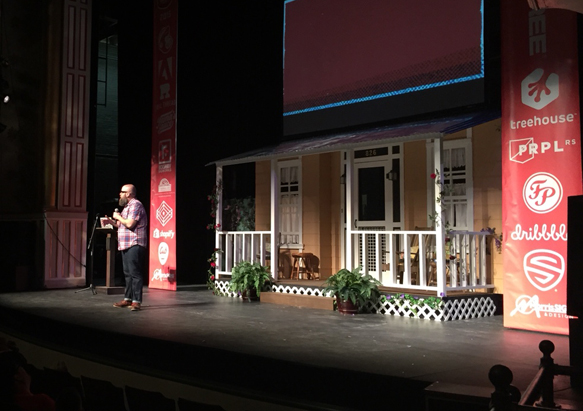
Do you ever feel like a fraud? Like you don’t belong in a creative community? Brian started out as a youth pastor in California before leaving it behind to become a graphic designer. His message is to “follow your weird:” to find something you like to do and continue to follow it. He celebrates being a nerd, attempting to take a typically pejorative term and turn it into a point of pride. Remember: Nerds designed your phone! Nerds designed the stage! Nerds argue about which sans-serif font to use, how to structure your HTML. He says you must work within your weaknesses—be honest about them and turn them into strengths.
—By Sarah Lawrence on April 10th, 9:55 AM

Shauna Panczyszyn, letterer and illustrator
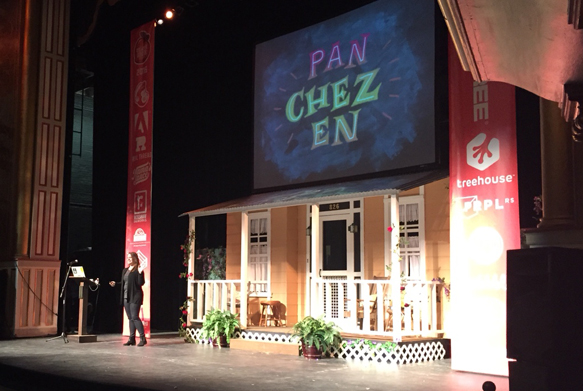
Shauna’s been drawing and lettering ever since she was a kid with a sharpie, destroying her mother’s white walls. Her parents did the right thing and provided her with paper, markers, more paper. After working on a lettering project as an intern right out of college, she got a call from an agency requesting more lettering work. Shortly after that, she was hired as a junior art director and then, without any explanation, fired three months later. She picked herself up, got a dog, and started freelancing. It took awhile before she was ready, but after a handlettered cover for Jacksonville Magazine, she was picked up to be represented by Illustration Limited—finally, she didn’t have to worry about pricing or promotion, she could focus on her art. Her takeaway here: “If you can’t do something, pay someone who can.” For example, pay an accountant to do your taxes if you need it.
Once Shauna was represented by an agency, she got the chance to design a cover for Scholastic, a piece for the Wall Street Journal, and the rest is history.
—By Sarah Lawrence on April 10th, 10:49 AM

Jason Craig
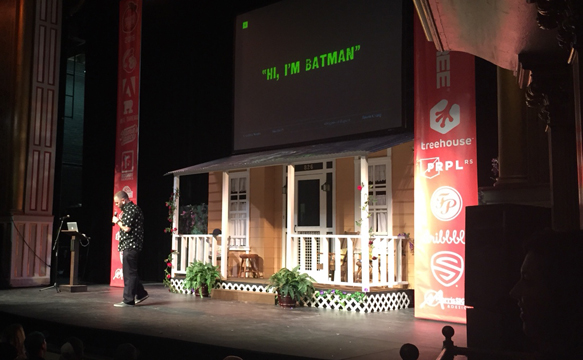
Jason’s not really on the internet—he doesn’t have a website or use Facebook. Most people can’t do this, but most people aren’t Jason Craig. So: what is an expert? What does that term even mean these days? He’s worked for Disney, DC Comics, Nike, Lowe’s, and other companies, so you could technically call him an expert (or, “legit,” as he says). He doesn’t put himself out there, he just focuses on what matters: show up, and do good work.
Jason’s built a habit over time of drinking black coffee—not because it’s cool, but because adding cream and sugar wastes time. He estimates that he wastes about eight hours a year simply adding these things to his drink. Stop that? You get a full work day back.
Be a force: when people ask your old bosses who worked for them, be the kind of person where your name comes up. Be included in that list, make an impression.
—By Sarah Lawrence on April 10th, 11:44 AM

Molly Jacques—calligrapher and letterer
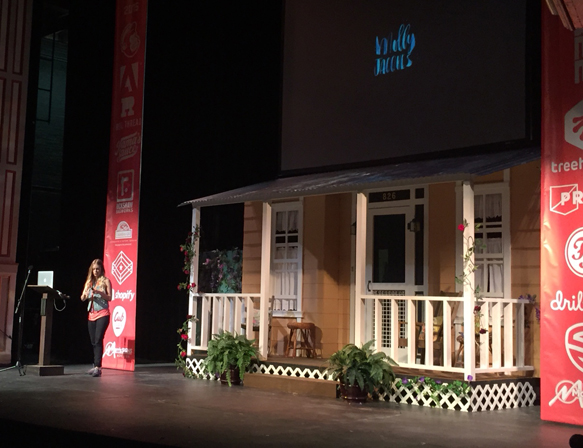
Molly’s talk today will be about using creative freelancing to build the life you want. She started by telling the audience about her journey to become a letterer—starting with a BFA in Illustration and limited business knowledge. Michigan’s economy was desolate, she had trouble finding a job. They picked everything up and moved all the way to Los Angeles, doing odd jobs until they found work that was fulfilling and made ends meet.
Learning about freelancing was tough—how do you solve a client’s problems? How do you get paid, how do you file taxes as a freelancer? Molly had to learn most of this on the fly, and start picking up on marketing trends to figure out how to build her business.
She didn’t necessarily want to be a wedding calligrapher, but knew that it was a booming business with women who had budgets to commission this type of work for their special day. In the wedding industry, you usually work directly with the client—so, the bride, or her mother. This is emotional, it’s tough and doesn’t always yield great feedback.
After building up her portfolio in the wedding industry, she was contacted by an art rep and had the chance to take her business even further. Art reps don’t just get you business—they can help with usage rights, licensing, and other administrative tasks. Molly was able to transition from the wedding industry to the commercial industry.
“It doesn’t matter if you’re the best designer in the world. If you’re pleasant and easy to work with, you can maintain great relationships with clients.”
—By Sarah Lawrence on April 10th, 2:35 PM

Peter Deltondo
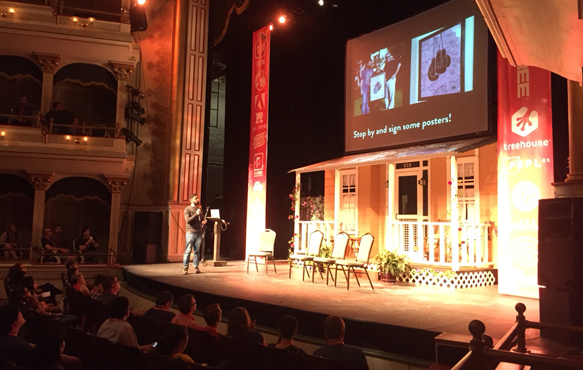
Peter runs a project called Design vs Cancer;, where designers contribute pieces for fundraising—80% of proceeds go to cancer fighters, and the rest goes to the designer as a royalty. He needs help, though. He can’t do this project all by himself, and needs people to contribute work and help out in any way they can.
—By Sarah Lawrence on April 10th, 4:10 PM

Aaron Sechrist
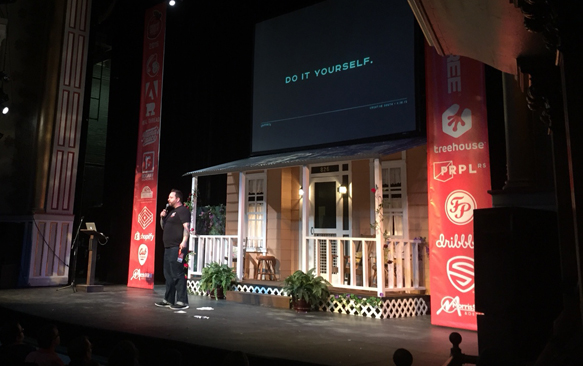
Aaron tells us that you can be terrible at making stuff, but don’t let that get in the way of what you’re doing. Everyone has an idea, it doesn’t need to be good—you need to have execution behind them (“For example,” he says, “Guy Fieri has like fifteen shows.”) He comes from a strong DIY aesthetic and reminds us that, while money doesn’t make you happy, it can buy the time you need to be happy. It buys you time to make the stuff you want to make. Your life isn’t built on one decisive, make or break moment. Life is built on learning from our mistakes. Make a plan, connect your vision to real life and execute it. Aaron cites Kanye West as an ideal creative role model. “Who actually thinks he’s good at rapping?” He asks the audience—only a few hands come up. “Do you think that ever stopped him? He either ignores criticism, or erases it, or finds a way to spin it.”
—By Sarah Lawrence on April 10th, 4:35 PM

Will & Susanna Gay
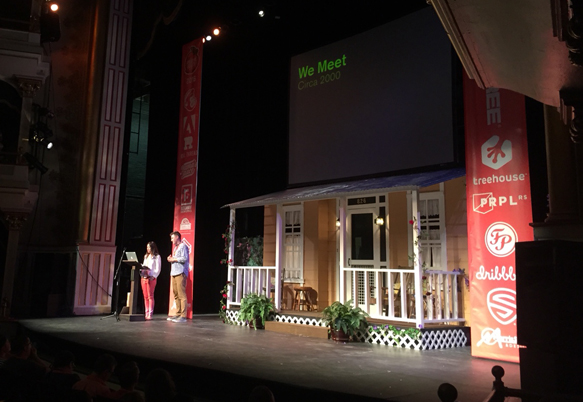
Will & Susanna (W&S for short) are designers with a lifetime of lucky entanglement with Disney. Susanna worked for Disney Design Group, which produced the goods they have for sale throughout the park. They designed backpacks, hats, and a lot of different things. They were the first people who didn’t really discuss their education, which was interesting. Most people are so shaped by their degrees or self-taught design skills.
W&S suggest sharing your thought process with the client—if they go through this process with you, they feel like they were a part of it and are more likely to agree with you. Susanna described the process of designing her most successful product for Disney ever—the tea bags from Alice and Wonderland. Disney executives told her that “Alice doesn’t sell.” She was able to convince them to get a good copywriter and test it out. Luckily, the tea became the highest selling product in the consumables category. Catherine Beaumont, the original voice of Alice, has the tea displayed in her kitchen.
—By Sarah Lawrence on April 10th, 5:20 PM

Tad Carpenter
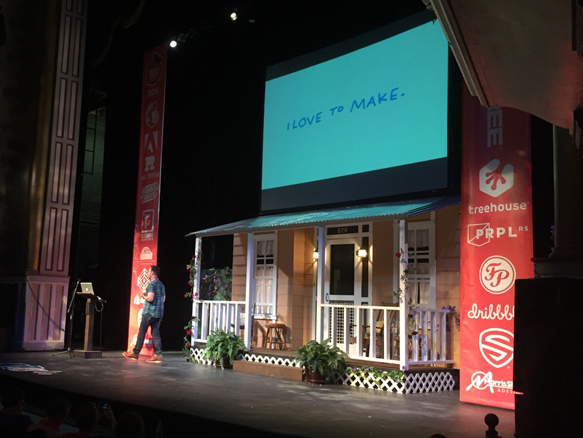
It’s the last talk of the day, but the room is still full for Tad Carpenter. HIs favorite quote is “The Harder I work, The Luckier I Get,” from a song by Buck Owens. Tad’s studio does brand identity, logos, mockups, apparel, and even snowboard designs. They’re breaking into more editorial work and children’s books, because the first experience a kid might have with art is with their books. He says that being from the Midwest really shaped who he is—rough around the edges and gritty (like the South!). Midwesterners aren’t showy. They act kind, and realize that talent is never enough. You have to be authentic and work hard.
Tad shows off his current side project, “Made in the Middle.” It’s a showcase of designers, illustrators, and other makers who live in the midwest. They’ve been able to produce all kinds of fun swag for the project for others to show their midwestern pride. In particular, Hallmark cards was founded in Kansas City, and Tad’s father has been an illustrator there for 40 years this June (He was photographed with the muppets)!
At the end of the day, remember: We get to do this. We get to do things we’re passionate about. Tad gets to teach students at the University of Kansas, and loves it. He stresses the need for strong concepts in design, the importance of taking risks.
His takeaway: Try to never let this work get un-fun.
And, that’s it for day two of Creative South. See you tomorrow morning!
—By Sarah Lawrence on April 10th,
Octavius Newman

The room isn’t nearly as full as it was yesterday, but to be fair, it’s nine in the morning on a Saturday. I’m even wearing my professional pajamas here. “What’s the difference between a superhero and a super villain?” he asks. “What they believe in. What if Superman’s belief system was different?” Octavius stresses the need for showing, not telling. You have to be able to communicate to other people. He wants to communicate that he’s not just running around making pretty things (and if you don’t even make pretty things, you’re communicating how you feel about quality), you’re making things that matter.
—By Sarah Lawrence on April 11th, 9:43 AM

Jen Mussari
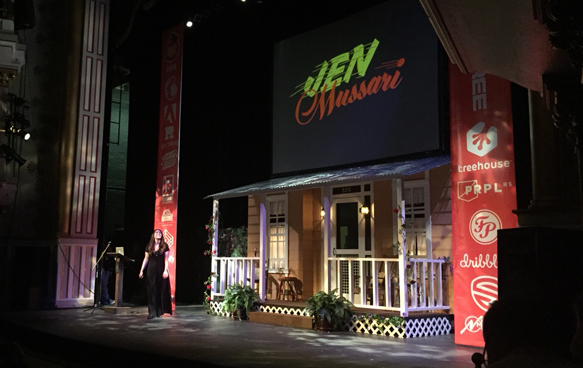
Jen grew up in a family that restored cars, and was so taken with the typography on old automobiles. Today, all of her work is drawn by hand—she doesn’t like creating letterforms on the computer. She has drawings and drawings in piles and piles of tracing paper—if you get it right physically, you only have to do a tiny amount of digital editing. Jen comes from a DIY-punk background but moved past that mindset to work on a commercial for Lincoln cars (that ended up running during the Grammys).
Her favorite projects are collaborations she does with friends. This is wonderful, since working from home as a freelancer quickly can become lonely. This brings Jen to Ghostly Ferns, a collaborative design studio in New York. They’re freelancers who specialize in specific things—if Jen does the lettering, Meg would build the website, Laura would do the illustrations. She recommends this structure of banding together with other specialists.
Her takeaway: Make Friends, Not Contacts. Be genuine! Don’t give off that desperate need to be networky. Be friends first, and the rest will follow.
—By Sarah Lawrence on April 11th, 10:36 AM

Lenny Terenzi
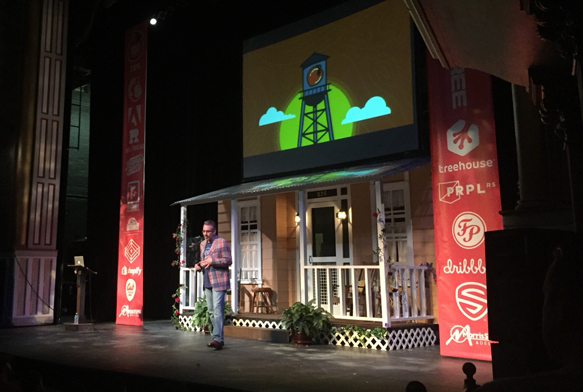
Lenny (of Hey Monkey) prefaces his talk saying it’s going to be about his life, about failure, and about creating. That is, how he totally ruined his career for 17 years and saved it in the last three. He gives a special shoutout to Paste favorites St. Paul and the Broken Bones. Lenny started in Photoshop as early as version 2..5 — there were no layers, and only one undo (designers these days would panic). He had a daughter with a disability, struggled to care for her with his wife, who he later separated from. Going through a divorce forced him to learn who he was, it made him realize he hated his job. He learned that if you need help, you need to ask for it—he went to a therapist, group therapy. Asking for help is not a sign of weakness, it’s a sign of strength.
So, life happened. He met someone new. It was a complete reverse of everything he knew about relationships. He was lost, and she found him.
Above anything else, Lenny says to do cool work for friends. One of his closest friends asked him to design the branding system for his new food truck, Urban Sugar. This was his first real project he sunk his teeth into that breathed life back into his creative practice. It re-lit the fire.
—By Sarah Lawrence on April 11th, 12:08 PM

Meg Robichaud
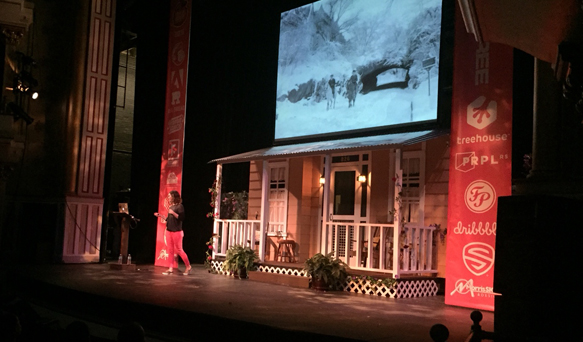
Meg spends a considerable amount of time in coffee shops. She’s from Canada, and she loves glitter. Although it’s widely considered a marketing tool, Meg loves Twitter because it’s like the Central Perk, the Tom’s Restaurant, the town pub of the internet. You can share you personal and professional successes and failures. She didn’t always love it like she does now. She was afraid to be wrong on the Internet, afraid to have a record of what she said. Her first real foray into social media was a website similar to Dribbble, where you can build connections with other designers and provide feedback and discussion—there was a real community.
You are a human first. You are a designer second. Meg discovered that by letting people into her life via social media, she was able to build a stronger community and find more meaningful relationships. She learned to be herself within a professional community. And to be yourself, you have to start with the courage to be imperfect. When you let go of being perfect, you work faster, more efficiently, and you come up with more solutions than you would have before.
—By Sarah Lawrence on April 11th, 12:50 PM

Meet the Crans
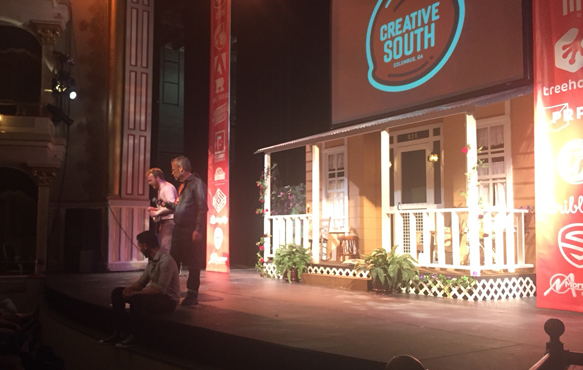
The Cran family is an incredible house of three designers: David, the patriach, Riley, his son, and Cade, their cousin. David’s talk went through his extensive history as a graphic designer, from provocative fine art projects where people thought he was murdering a goldfish, to using the very first Mac, to vector art and screenprinting. Cade went through his considerably shorter history—he wasn’t good at school, didn’t like sitting still and wasn’t able to focus in long classes. He didn’t go to school for art later, he decided to work as a demolisher and quit that shortly after. Cade found his way by working with Riley and David, learning design from them and becoming a force to be reckoned with. Riley, who’s talk was rushed from a lack of time, quickly went through his life and what it was like to grow up as the child of a designer. He touched on his time as a founder and the operator of Lost Type Co-Op, a collective responsible for typefaces we can promise you have seen at least fifty times in the last month.
—By Sarah Lawrence on April 11th, 3:17 PM

Matthew Muñoz

The Art of Boundaries. Yes, No, Maybe. How do you decide to do something? In some cases, boundaries are terrible—they hold you back. In other cases, boundaries protect you, like a space suit. Boundaries can liberate you, like a creative restraint. Matthew stresses the need for drawing careful boundaries to decide what to focus on. For instance, in school, you can’t study everything. You have to pick a few things to focus on, and that is your boundary. Boundaries are not permanent, you can expand them as you go.
After school, Matthew spent time as a designer at IBM. He learned to pitch to bigger clients and win bigger accounts. His boundaries expanded. He learned to be critiqued by clients instead of just fellow art students (because we all know client criticism can be, well, confusing). He started giving back to Raleigh by designing publications. And he shows that, each step of the way, you expand your boundaries.
—By Sarah Lawrence on April 11th, 3:36PM
GET PASTE RIGHT IN YOUR INBOX
The best music, movies, TV, books, comedy and more.